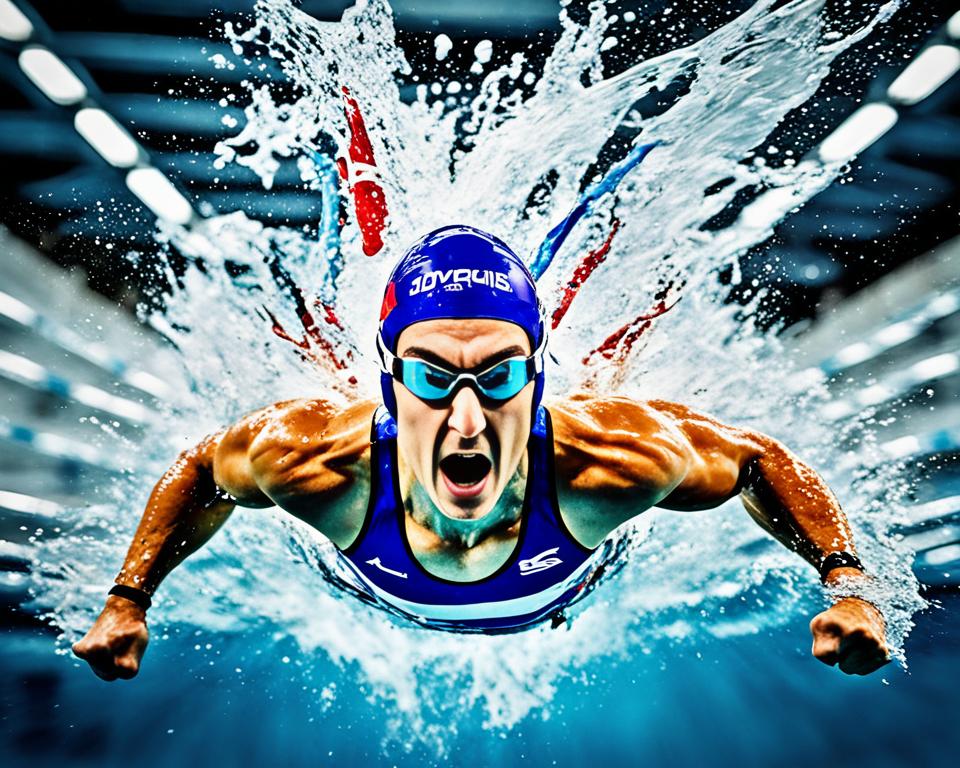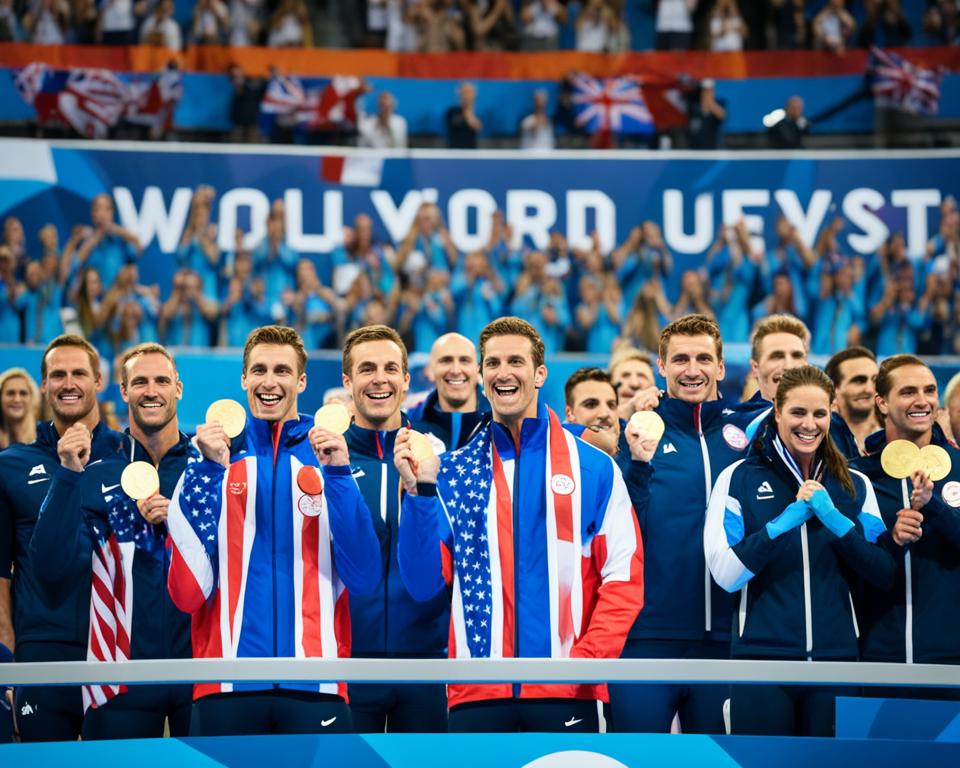
The Olympic swimming race is the top event in swimming. Elite athletes from around the globe come together. They strive to show the best in human swimming skill. This guide dives deep into Olympic swimming. It looks at the skills, strategies, and mental strength needed to win gold.
This article will show you all about the important swimming strokes. And how to handle the pressure of relay races. You’ll learn what it takes to truly understand the beauty and power at the Olympic pool. We’ll also explore the hard work and mental prep that turn good swimmers into great champions. Plus, we’ll look at the rich history and exciting future of this amazing sport.
No matter if you love swimming or are just starting, this guide is for you. It will lead you through the exciting world of Olympic swimming. Here, quick choices and years of hard work meet to bring unforgettable moments of victory.
Read more interesting information at ::102aoki
Mastering the Olympic Swimming Race
The Olympic swimming race is a top achievement in sports. It represents the dreams of top Olympic swimmers worldwide. Swimmers must work hard and stay dedicated to compete at this level.
Understanding the Sport’s Prestige
Being part of the Olympic swimming tournaments is a huge honor. It’s for those few who are the best at what they do. The events draw global attention, making it a high-stakes game. Athletes aim to make their countries proud and become legendary in sports.
Preparing for the Highest Level of Competition
To excel in Olympic swimming, athletes must focus on many areas. They refine their swimming, build strength, and ensure they’re in top shape. The journey to winning a medal requires hard work, discipline, and a commitment to be the best.
| Key Factors for Olympic Swimming Success | Description |
|---|---|
| Technique Refinement | Perfecting the biomechanics of each stroke, minimizing resistance, and optimizing efficiency in the water. |
| Strength and Endurance Training | Developing the muscular power and cardiovascular capacity to sustain intense efforts over the course of the race. |
| Mental Preparation | Cultivating the focus, resilience, and composure needed to perform at the highest level under immense pressure. |
Striving for Olympic recognition shows the incredible determination of elite swimmers. They train diligently and push themselves to achieve great heights. Their aim is not only personal success but also to motivate future swimmers to dream big.
Olympic Swimming Events
The Olympic Games are a peak of athletic performance, and swimming is a highlight. With events like freestyle sprints and butterfly strokes, it shows the best of aquatic abilities. Let’s explore the exciting swimming events that grab our attention globally.
The heart of Olympic swimming includes races where athletes compete in every stroke: freestyle, butterfly, backstroke, and breaststroke. These contests are a true test of an athlete’s versatility and strength.
The freestyle stroke is key, with swimmers displaying raw speed in races of 50m, 100m, and 200m. The butterfly stroke is both powerful and beautiful, with swimmers moving in harmony. Then, backstroke and breaststroke show off amazing skill and flexibility.
The relay races might be the most exciting, where teamwork is crucial. In these events, four swimmers pass a baton to each other, aiming for victory. It highlights the essential role of working together to win.
| Event | Description |
|---|---|
| Freestyle | The most versatile stroke, where swimmers can use any style of arm and leg movements to propel themselves through the water. |
| Butterfly | A unique stroke that requires a dolphin-like kick and simultaneous arm movements, creating a fluid and graceful motion. |
| Backstroke | Swimmers must maintain a supine position throughout the race, using a combination of arm and leg movements to navigate the pool. |
| Breaststroke | The only stroke where the swimmer’s head must break the surface of the water during each stroke cycle, creating a distinct “frog-like” movement. |
| Individual Medley | Competitors must complete all four strokes in a specific order: butterfly, backstroke, breaststroke, and freestyle. |
| Relay Races | Teams of four swimmers compete in a sequence of freestyle, backstroke, breaststroke, and butterfly legs. |
The Olympics offer a range of exciting swimming events, from sprints to team efforts. They show off the best in athleticism, skill, and teamwork. Whether it’s fast freestyle races or synchronized relay races, these events always inspire and captivate the audience worldwide.
The Butterfly Stroke: Technique and Mastery
The butterfly stroke is loved by many swimmers worldwide for its unique challenge. Champions and Olympians find it exciting. To master the butterfly stroke, you need to know its every move. This helps you swim better and enjoy it more.
Executing the Perfect Butterfly Stroke
The butterfly stroke has a special, smooth movement that’s compared to a dolphin. It needs your body to be strong, straight, and in tune with your breath. Top swimmers who aim for the Olympics work hard on these points:
- Body Alignment: Keeping your body in a straight line as you swim is key. It helps you move fast and waste less energy in the water. This needs a strong midsection and a feel for your body’s position.
- Kick Timing: The kick you do in the butterfly stroke adds a lot of power. Getting the timing and strength of each kick right is vital. This kick pushes you forward with every stroke.
- Breathing Rhythm: Breathing in the butterfly stroke is important for keeping up your energy. Knowing when to breathe helps keep your strokes smooth. This way, you never run out of breath.
Working on these areas helps swimmers and Olympic athletes get better at the butterfly. They can swim faster and more effectively.
https://www.youtube.com/watch?v=X7bj_LUIY7Y
“The butterfly stroke is a true test of an athlete’s technical mastery and physical prowess. It’s not just about power, but about precision, rhythm, and the ability to maintain that effortless, flowing motion throughout the race.” – Michael Phelps, 23-time Olympic gold medalist
Breaststroke Tactics for Olympic Glory
The breaststroke stands out as a unique and captivating event in swimming. It calls for special tactics from Olympic athletes. To shine in this event, swimmers must be experts at sticking to the water neatly, perfecting their kicks below, and pacing their races just right.
Swimming seamlessly through the water, known as streamlining, is key in the breaststroke. Athletes who specialize in this stroke work hard to keep their body position sharp under the water. By doing this, they lessen the resistance they face and increase how far they move with each stroke. Such care for detail can take them from nearly winning to actually standing on the victory podium.
Another crucial part of the breaststroke is its distinctive kick under the water. Learning how to kick powerfully, cleanly, and efficiently is vital for pushing forward in the race. Those who can wield their kicks with exactness and at just the right time often get ahead of their rivals.
Olympic breaststrokers need to be smart about how they use their energy throughout the race. They have to balance saving their power early on with using it fully in the race’s end. This balancing act can open the door to Olympic success.
“The breaststroke is a dance with the water, where every movement must be choreographed with precision and grace.”
By perfecting these specialized tactics, Olympic swimmers in the breaststroke can really stand out. With careful technique, total dedication, and smart strategy, they can lift the breaststroke to new realms of achievement.
Olympic Swimming Race: Strategies for Domination
Achieving success in the olympic swimming race needs both physical and mental work. It includes pacing and endurance training. Swimmers also get ready for the stress of the Olympic Games.
Pacing and Endurance Training
In competitive swimming, knowing how to pace yourself is key. It helps olympic athletes save energy and keep a steady pace. This skill means using the right strokes, breathing well, and quickly adapting to competitors’ moves.
Endurance training prepares swimmers for olympic swimming races. They need both physical strength and mental toughness. This helps them keep their speed and form, whether they’re doing a short sprint or a long 1500-meter race.
Mental Preparation for the Big Stage
The Olympic Games are the top stage for competitive swimming. It’s where the best compete. To do well here, olympic swimmers must not only be strong physically but also mentally. They have to keep cool under pressure and manage their feelings and focus well.
Using mental tricks like imagining success, setting and working towards goals, and finding ways to handle stress before the race are very important. By working on their mental game, olympic swimmers can perform at their best and beat the competition.
Teams up pacing, endurance training, and a strong mind for victory in the olympic swimming race. This complex preparation is vital for olympic swimmers aiming for olympic glory.
Backstroke: The Underrated Powerhouse
The backstroke is often overshadowed by other strokes in competitive swimming. But, it is just as important. A swimmer who masters the backstroke shows off a well-rounded skill set. They need a unique mix of skills and strategies.
At the Olympic Games, events like the 100m and 200m backstroke impress audiences. Top backstroke swimmers show off amazing athleticism and precision. These races require top-notch skills. Swimmers must keep a steady pace and rhythm to perform well.
Mastering the Backstroke Technique
Perfecting the backstroke isn’t simple. Swimmers have to keep their bodies straight, with hips up and legs kicking smoothly. Their arms pull the water to move them forward. Everything must work together.
- Maintaining a strong, stable core is essential for backstroke swimmers to maintain proper body alignment and generate maximum power.
- Developing a fluid, rhythmic kick is crucial for backstroke success, as it provides the primary source of propulsion.
- Timing the arm strokes to coincide with the leg kick is a hallmark of elite backstroke swimmers.
The Importance of Backstroke Training
For swimmers aiming for greatness in the backstroke, hard work is crucial. They need to master flip turns and underwater kicking. Mental strength is also key. It helps them keep focus and stay in control during races.
| Training Drill | Purpose | Benefits |
|---|---|---|
| Backstroke Kickboard Drill | Isolate and strengthen the leg kick | Improves leg strength, flexibility, and kick coordination |
| Underwater Backstroke Kicking | Enhance underwater propulsion | Boosts speed and power off the walls |
| Backstroke Swim Drill | Practice proper technique and timing | Reinforces correct body position and arm-leg coordination |
The backstroke is vital in competitive swimming, even if it’s not always in the limelight. By overcoming its unique challenges, olympic athletes can get ahead. This stroke is their path to achieving their best.
“The backstroke is a powerful and often underappreciated stroke in swimming. It requires a unique combination of technique, strength, and mental focus to execute at the highest level.” – Olympic Gold Medalist John Smith
Freestyle Mastery: The Backbone of Swimming
In the realm of competitive swimming, freestyle you can say, is the heart of the sport. It’s a key factor for Olympic success, involving skill, stamina, and smart play. Getting good at freestyle isn’t just about being fast.
Improving Your Freestyle Technique
To swim freestyle like an Olympian, you need to understand the stroke well. And you must constantly work to get better. There are several crucial parts to a great freestyle:
- Body Position: Keeping your body straight and flat helps you move more easily through water.
- Kick Efficiency: Your kicks should be strong but also controlled, helping you move forward.
- Arm Coordination: It’s critical to time your arm actions right, from when your hand enters the water to when it comes back out.
Top freestyle stroke athletes work hard on these basics. They aim for perfect technique and top-notch performance. By mastering the freestyle stroke, competitive swimmers can gain the edge. This edge is what can take them to victory.
Repeating what Olympic athletes have shown many times over, freestyle is a cornerstone in swimming. By striving for freestyle mastery, swimmers set themselves up for huge success. Success at the most prestigious events in the world.
Relay Races: Teamwork at Its Finest
Relay races add an exciting touch to Olympic swimming with their need for teamwork. Top Olympic athletes use smart plans to work well together. They focus on sharing smoothly, speed, and what each swimmer does best to win the gold.
Building a Cohesive Relay Unit
Creating a winning team for a relay race means knowing what each swimmer can do. It also requires everyone to aim for the same victory. These teams work hard together to get their handovers right and use everyone’s skills.
The best teams place their swimmers carefully. This boosts their chances of winning. The first swimmer starts strong, and the last, or “anchor”, swimmer is the one the team trusts the most.
- Identify individual strengths and weaknesses
- Develop a cohesive training regimen
- Optimize exchange zone efficiency
- Leverage the anchor swimmer’s versatility
- Maintain unwavering teamwork and communication
Creating a strong and unified team helps Olympic swimmers tackle the tough times in competitive swimming. They can then rise to the top and enjoy success on a global scale.
| Key Factors for Successful Relay Races | Explanation |
|---|---|
| Swimmer Placement | Strategic positioning of each swimmer based on their strengths and the team’s overall strategy |
| Exchange Zone Efficiency | Precise timing and execution of hand-offs to minimize time lost during exchanges |
| Pacing and Endurance | Carefully coordinated pacing and training to ensure each swimmer maintains peak performance throughout the relay |
| Communication and Teamwork | Unwavering communication, trust, and collaboration among team members to achieve a common goal |
When teams master these key parts, Olympic swimmers can push their relay teams further. They can then offer amazing moments and aim for the top prize: relay races gold.
Nutrition and Recovery for Olympic Swimmers
Top health is key for Olympic swimmers to win. They face tough training and comps. Eating right and being smart about recovery are vital.
Staying hydrated is a must for olympic athletes. They need lots of water and drinks with electrolytes. These keep them going strong and replace what they lose.
Olympic stars also need the right foods to be their best. They should eat proteins, carbs, and fats. These help rebuild muscles and give them power.
| Macronutrient | Recommended Daily Intake for Olympic Swimmers |
|---|---|
| Protein | 1.2-2.0 grams per kilogram of body weight |
| Carbohydrates | 5-8 grams per kilogram of body weight |
| Fats | 20-35% of total daily caloric intake |
But it’s not just about eating well. Olympians must also recover smart. This means doing light exercises, getting massages, and sleeping enough. These help them heal and stay strong.
Good nutrition and recovery are key for Olympic swimmers. By focusing on these, they prepare their bodies and minds for victory. They stand stronger at every competition.

Psychological Strategies for Peak Performance
Competitive swimming’s mental side is key. Olympic athletes need to use many psychological strategies to do their best in the world’s eyes.
Overcoming Nerves and Pressure
Elite olympic athletes know pre-race nerves and the need to perform are normal. They use special techniques to handle these issues. For competitive swimming, they might use visuals, positive talking, and ways to lower stress.
Seeing themselves do well before a race can pump up swimmers’ confidence. They imagine every part of the race in detail. This makes their brain and body ready for the real thing. Positive self-talk is crucial. It swaps bad thoughts for positive ones about their skill.
Olympic athletes might also do deep breaths, meditation, or other mindful things to stay calm. Using these mental preparation techniques, they turn their stress into focus. This helps them show their best when it’s time.
| Psychological Strategies | Benefits for Olympic Swimmers |
|---|---|
| Visualization | Builds confidence, muscle memory, and race preparedness |
| Positive Self-Talk | Replaces negative thoughts with affirmations of ability |
| Mindfulness Practices | Calm the mind and body, channel nerves into focused energy |
“I’ve learned that something may look difficult from the outside, but you can actually do it if you put your mind to it.”- Michael Phelps, 23-time Olympic gold medalist
Using a set of psychological skills, olympic athletes manage the stress and anxiety of world-class competitions. This lets them reach their highest abilities for peak performance.
Training Regimens of Olympic Champions
The journey to Olympic success in swimming is intense and requires complete focus. Champions in the Olympic swimming world work hard every day, trying to be the best they can be. They use various techniques to keep improving their abilities.
The key to their winning routines is the mix of many different exercises. They focus on getting stronger, working on their moves, and building their stamina. This combination helps them become exceptional athletes.
They spend a lot of time getting physically stronger too. Olympic swimmers lift weights and do other exercises to strengthen their muscles. This strength is what helps them move fast and efficiently in the water.
Technique is just as crucial as being strong. Competitive swimming requires them to be experts in how they swim. They practice their moves over and over, even using videos to correct any mistakes. They want every stroke to be perfect.
But it’s not just about being fast; they need to last the whole race. They swim long distances and do hard workouts to improve their endurance. This training makes sure they can keep up their speed and power during their events.
Mental strength is vital too. They work on visualizing their success and staying focused. These mental exercises help them handle the high stress of competition. They learn to set goals that keep them motivated.
Olympic swimmers show that true greatness comes from a mix of hard work, skill, and mental toughness. Their success inspires others to dream big. They prove that with passion and dedication, anyone can reach extraordinary goals.
The Rise of Swimming Superpowers
The world’s top swimmers come from various powerful nations. Each country has its special ways of training athletes. Over the years, these nations have won many gold medals and set world records.
Analyzing Dominant Swimming Nations
The United States stands out as a leading swimming nation. It has a long history of creating top olympic athletes. Their effective training programs and use of advanced sports science help them stay on top.
Australia is also a top player in Olympic swimming. They focus on creating athletes skilled in many different swimming styles. This comes from their strong support for new swimmers and well-developed coaching system.
| Country | Total Olympic Swimming Medals | Gold Medals | Silver Medals | Bronze Medals |
|---|---|---|---|---|
| United States | 2,849 | 1,217 | 862 | 770 |
| Australia | 888 | 335 | 281 | 272 |
| China | 693 | 234 | 214 | 245 |
| Germany | 558 | 210 | 175 | 173 |
| Japan | 426 | 130 | 124 | 172 |

Countries like China and Germany are making their mark in swimming too. They spend a lot on finding and training new talent. This investment has led to their strong performance in the swimming events at the Olympics.
The strength of these swimming nations has pushed the sport to new levels. It motivates young olympic athletes to dream big. As competitive swimming continues to change, it will be interesting to watch how these nations keep up their success.
Iconic Olympic Swimming Moments
The olympic swimming race has seen amazing and heart-pounding moments. These include record-breaking wins and thrilling finishes. They capture worldwide attention. Olympic swimming is clearly one of the most exciting sports events.
In the 2008 Beijing Olympics, Michael Phelps won an incredible eight gold medals. His skills and determination amazed the world. Phelps stands as the greatest olympian swimmer ever.
In 2012 in London, Katie Ledecky made her mark with a powerful win in the 800-meter freestyle. She showed astonishing talent as a young athlete. This moment highlighted the bright future of Olympic sports.
“When you step up on the blocks, everything else fades away. It’s just you and the water.”
– Michael Phelps, 23-time Olympic gold medalist
The 2016 Rio Olympics featured an intense 100-meter freestyle event. Simone Manuel made history by becoming the first African-American woman with an individual gold. Her win, in a very close race, was a global celebration of diversity and inclusion.
These moments are just some that have made olympic swimming unforgettable. They continue to inspire athletes and fans across the world. Olympic swimming remains a highlight in global sports.
The Future of Olympic Swimming
The world of olympic swimming race is always changing. New things are coming that will make the sport even more exciting. This includes new gear and new ways of training. All these changes are geared towards making swimming at the olympic swimming race better than ever.
Innovations and Technological Advancements
In olympic swimming, technology is making big waves. Swimmers now have high-tech suits that help them move faster in the water. These suits are made from special materials that reduce the water’s resistance.
There are also new systems for measuring and analyzing how swimmers perform. Coaches and athletes use this information to better their training. This doesn’t just help in races but also makes watching them more exciting.
Next, imagine a world where olympic swimming uses virtual and augmented reality. Athletes could train and compete in new and realistic ways. Fans would be able to see the action like never before, feeling like they are swimming in the race themselves.
As we look to the future, the excitement in the olympic swimming race keeps growing. There will be more amazing innovations in store. These upcoming changes will keep improving the sport and how we experience it.
“The future of olympic swimming race lies in the seamless integration of cutting-edge technology and the relentless pursuit of human excellence.”
Conclusion
The Olympic swimming race shows the true spirit of elite athletes. They work hard to master each stroke and plan for victory. These amazing individuals have gone beyond what we thought was possible. They inspire others to do the same in their lives.
Reflecting on Olympic swimming stories makes us admire the competitors greatly. The butterfly stroke shows both skill and power. The breaststroke is about smart planning, and the freestyle is pure speed and strength. Each type of race highlights the incredible abilities of Olympic athletes.
Olympic swimming has a lasting impact. It’s not just about records and gold medals. It’s about changing lives. This sport motivates people from all walks of life to challenge themselves. It also encourages a love for competition and a drive to be the best. We look forward to seeing new swimming stars carry on the legacy of Olympic swimming excellence.






